Time’s Arrow:
Or the Nature of the Offence
A kind in glass and a cousin, a spectacle and nothing strange a single hurt color and an arrangement in a system to pointing. All this and not ordinary, not unordered in not resembling. The difference is spreading. —“A Carafe, that is a Blind Glass,” Tender Buttons, Gertrude Stein
In Martin Amis’ 1991 novel Time’s Arrow: or the Nature of the Offence (from which this essay borrows its title) the events occur in a reverse chronology, undermining the one-directionality an “arrow of time” might suggest. The non-linear orientation of “time’s arrow” has chronologically informed the composition of this essay—beginning with the “long, thin stick, pointed at one end, that can be shot from a bow,” followed by the “sign, which points in a particular direction.” Admittedly, there are already many articulations of the history (or histories) of the arrow, but the latter is often represented myopically within the canons of weaponry or signage—and with the two hardly ever discussed in tandem. Personally, I do not believe that the two are wholly separate.
In an attempt to bridge this dichotomy, this essay will read into the less considered, but nonetheless inextricable relationship between the two arrows. I began from an intuition that by looking at the arrow and following its historical evolution from object, to metaphor, to (emptied out) sign, I could perhaps also articulate something about Modernity.
My fascination with the arrow began in the later parts of 2017. While going through a persistent bout of difficult days, when even basic to-dos felt like crippling anxieties, my mind wandered. What to do with the madness of an infantilized mind, when Modernity constantly calls for an ethos of progress and efficiency? Confection was my distraction of choice. It was a hazy night in November when I noticed a tiny arrowhead on the wrapper of my KitKat. “Tear here” was as much as it meant to say, but in my state of regress it registered in my mind as something different, more sinister. My stomach sinking, the little triangle arrowhead, no bigger than a crumb, felt like it had rammed its edge straight through—a stinging prerogative from Nestlé, intruding into private spaces that I had thought were sacred, imploring my cold, limp fingers to act.
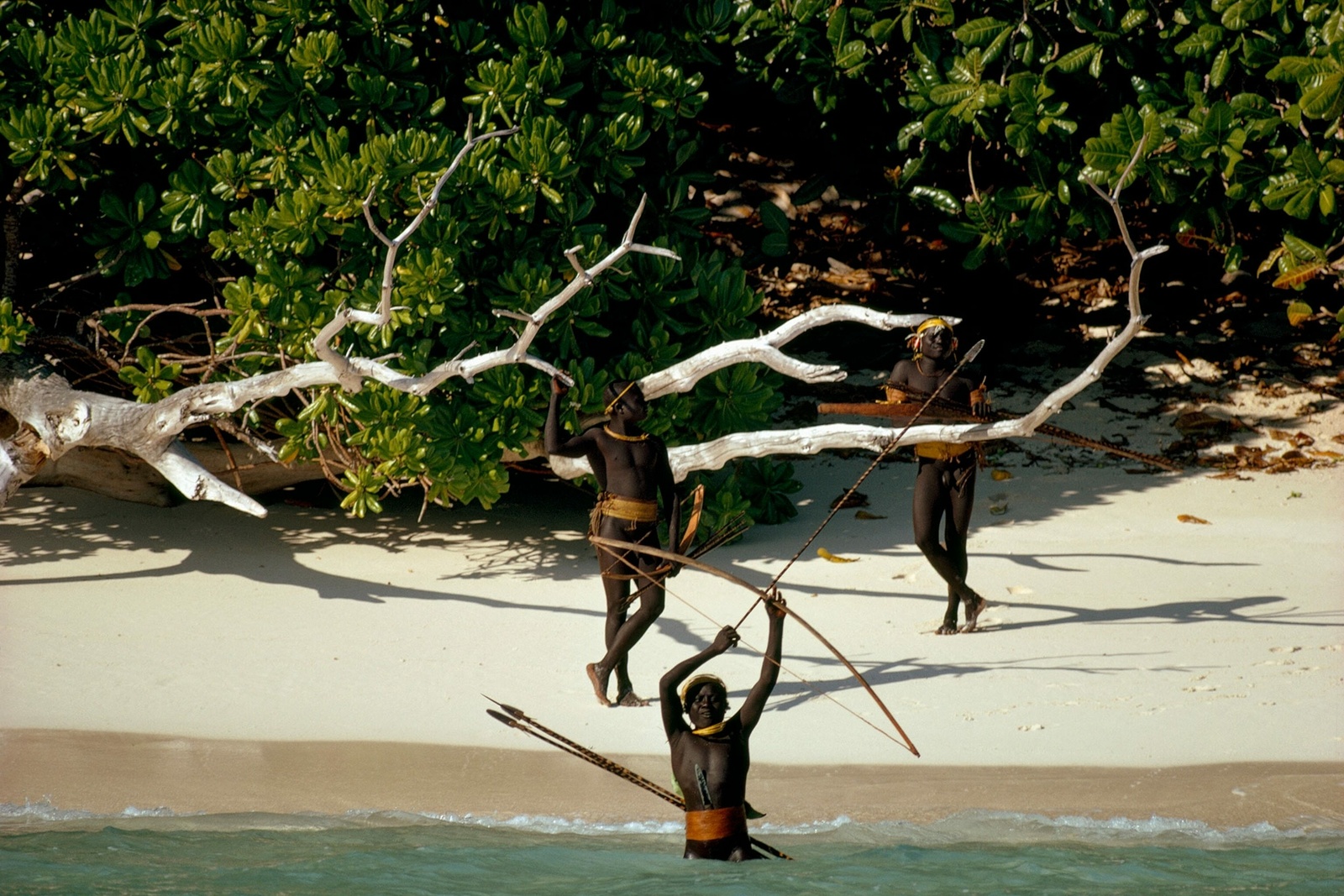
Part 1:
The ‘long, thin stick, pointed at one end, that can be shot from a bow’
1.1 In Recent News
11 .11 . 18, ILFORD, UK (UK Press Association): Pregnant Mother Killed In Crossbow Horror That Leaves Baby Fighting For Life After Emergency Caesarean
Sana Muhammad, 35, was shot and killed with a crossbow by her ex-husband, Ramanodge Unmathallegadoo, 50, in Ilford, East London. Unmathallegadoo had been hiding out in her family’s garden shed before attacking her in their kitchen, in front of her husband and five children. Muhammad was eight months pregnant at the time of the murder. Emergency paramedics would later safely deliver the baby—who had been missed by mere inches—with the arrow still lodged in his mother. That evening, the victim’s husband, Imtiaz Muhammad, told The Evening Standard:
I can’t help thinking she took my arrow. Maybe it should have hit me. The kids were all there, it was horrific.
Later in parliament, Ilford North MP Wes Streeting would probe British Prime Minister Theresa May to urgently and seriously revisit the Offensive Weapons Bill, and toughen the scope of laws governing the sale, possession, and use of deadly weapons.
21 . 11 .18, PORT BLAIR, INDIA (Reuters): American Missionary Killed By Tribe On Remote Indian Island
John Allen Chau, 26, was slain on North Sentinel Island, India. With the illegal assistance of six fishermen, the American had travelled to the far-flung Andaman and Nicobar Islands to reach the off-limits North Sentinel Island—home to the Sentinelese, one of the planet’s most impenetrable and undiluted hunter-gatherer societies. Chau had convinced himself that the secluded island was “Satan’s last stronghold,” and was on a self-propelled mission to convert them to Christianity. In his journal, he recorded that on his first attempt to hand over fish and other gifts, a Sentinelese boy had shot an arrow at him. It narrowly missed, piercing through his waterproof Bible instead:
I grabbed the arrow shaft as it broke in my Bible and felt the arrow head. (…) It was metal, thin, but very sharp.
Despite this close shave, Chau would make further attempts to reach the island—it was only upon his fourth attempt to make contact that he was shot and killed by arrows. The fishermen who had been assisting him saw his body being dragged and buried in the sand the morning after.
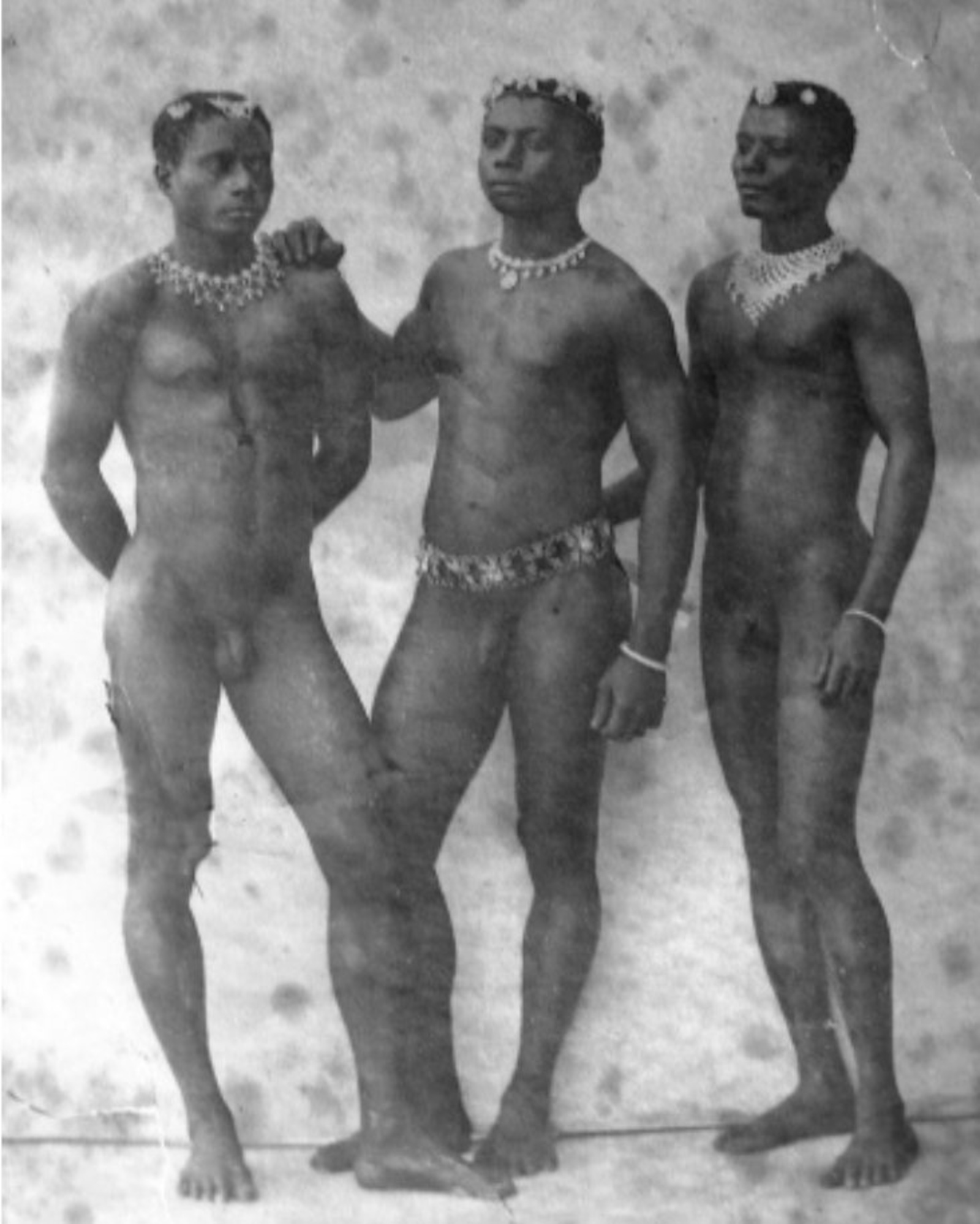
From 1879 to 1901, the British naval commander Maurice Vidal Portman was assigned to the islands to administer, document, and pacify the islanders. In this picture, Portman posed male tribe members of the Andaman Islands after homo-erotic Greek statues.
Historically, the Sentinelese have a record of being hostile towards outsiders, and for good reason. During 19th-century British colonialism, aboriginal tribes of the Andaman and Nicobar Islands were “discovered” and regarded as fascinating primitive specimens, and subjects for zoological study, by their “civilized” European explorer counterparts. The rapid growth of opportunistic anthropological interest resulted in an abrupt influx of Europeans to the region, introducing foreign diseases that the islanders lacked immunity against and eventually leading to the decimation of large native populations.
For all his wide-eyed eagerness, Chau inhabited the same strain of Western conceit of past colonizers, and his insistence to theologically convert the Sentinelese with the Holy Bible was met with derision.
By 2018, both of these bow-and-arrow homicides had achieved international news coverage and viral statuses on social media platforms. But despite their similarities, the nature of the offenses perpetrated by these weapons were regarded in disparate tonalities. Journalists and readers alike concurred that Chau had been largely responsible for eliciting aggression from the societally-alienated islanders, and that it would be absurd to exert modern protocols of punishment against them for his death. By contrast, Unmathallegadoo’s deliberate choice of the crossbow—a weapon loaded with connotations of primitive savagery—in this day and age represented a reprehensible abandonment of contemporary logic and regression to barbarism.

Meme from Instagram user @humansoflate depicting Chau on the Sentinelese shores in the game Age of Empires.
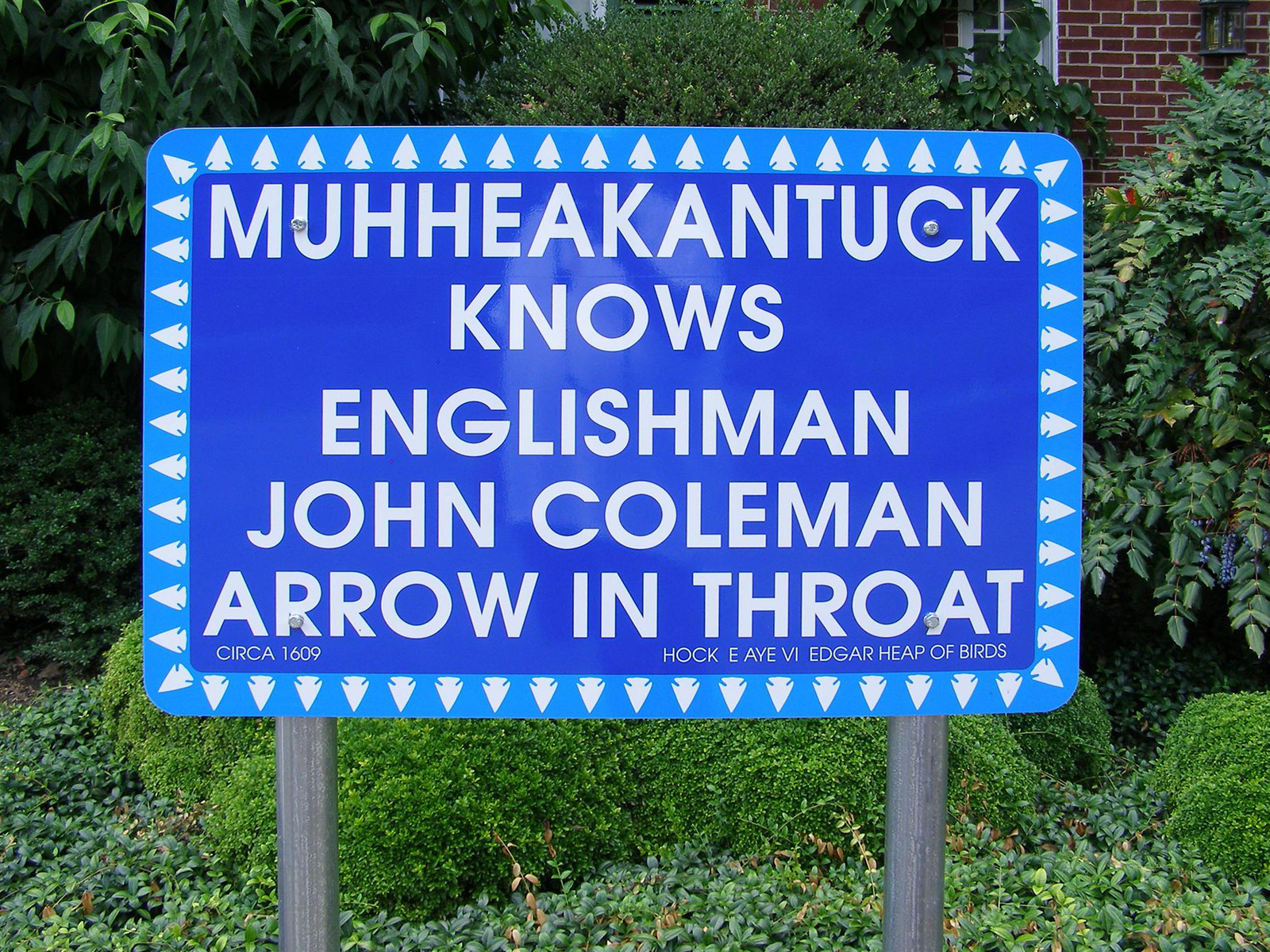
This plaque is from the series Please the Waters by artist Edgar Heap of Birds. John Coleman was a crew member of the ship the Half Moon, owned by Henry Hudson (the namesake of Hudson’s Bay Company). Coleman was killed by Native Americans by an arrow to his neck on September 6, 1609, five days after the arrival of the first Dutch and English sailors from the Dutch East India Company. This expedition would lay the foundation for the Dutch colonization of the east coast of America in the 17th Century (later named ‘New Netherland’).
1.2 The Takintazipa
On the right is the takintazipa, a hunting bow used by the Lakota Sioux people of North and South Dakota, America. It measures 1.2 meters long and is made out of wood and sinew (takan = “sinew,” itazipa = “bow”). It is covered with snakeskin and its ends are bound with hide. It has bands of colored quill and bead-work on both arms. The arrow used with this takintazipa would likely have had turkey tail-feathers (since these were considered the best for fletchings). Its shaft would have been made out of a flexible wood (such as juneberry) and the material of its attached arrowhead would have varied by purpose (but quite possibly flint). Combined, the principle function of this Sioux bow-and-arrow was to hunt buffalo, although it was also used for the purpose of warfare.
The takintazipa pictured here is owned by the Pitt Rivers Museum of Anthropology and World Archaeology in Oxford, UK. It is displayed in the museum’s “Primitive Weapons” section on the second floor, in a glass display alongside other bows and arrows from across the world. In the display, these artifacts are supplemented by short exhibition texts that surmise how they might have previously been used for fishing, hunting, or warfare in their native land—activities that sustained life itself (of course, by ending another).
The takintazipa’s trajectory from Lakota land to the Pitt Rivers Museum can be thought to follow a similar epistemology. Although it might have been conceived for the purpose of hunting, it was dispossessed from its place of origin in 1842, when Edward Martin Hopkins (the governor-general secretary of Hudson’s Bay Company) acquired it while on a round-the-world journey—effectively ending its life as a weapon in the process.
On the Pitt Rivers website, details of the takintazipa’s provenance are suspiciously vague. “Interesting and puzzling” are words the museum uses to describe it, before ultimately putting forth the proposition that the item was acquired by fairly innocent means:
The ghost-written account of Sir George Simpson’s journey, Narrative of a Journey Round the World, during the years 1841 and 1842 (Simpson, 1847), is very informative, but mentions no contact with the Sioux nation whatsoever. It seems he spent most of the North American leg of his journey travelling through present-day Canada, and did not approach the Lakota. This said, he came into considerable contact with the Cree and Blackfoot, who had both military encounters and alliances with the Sioux. It may be that Hopkins acquired these Sioux weapons by this means.
Regardless of its means of acquisition, the takintazipa now lies static in a crystal morgue, historicized as a valuable artifact of the old world (old as in pre-something). As I stood in front of the display, I felt a sense of both paradox and separation: despite the takintazipa’s previous potentialities, the glass partition served foremostly to guard its safety, and not my own. The fact that my engagement was limited to passive spectatorship was clear to see—and indeed it was designed to be so.
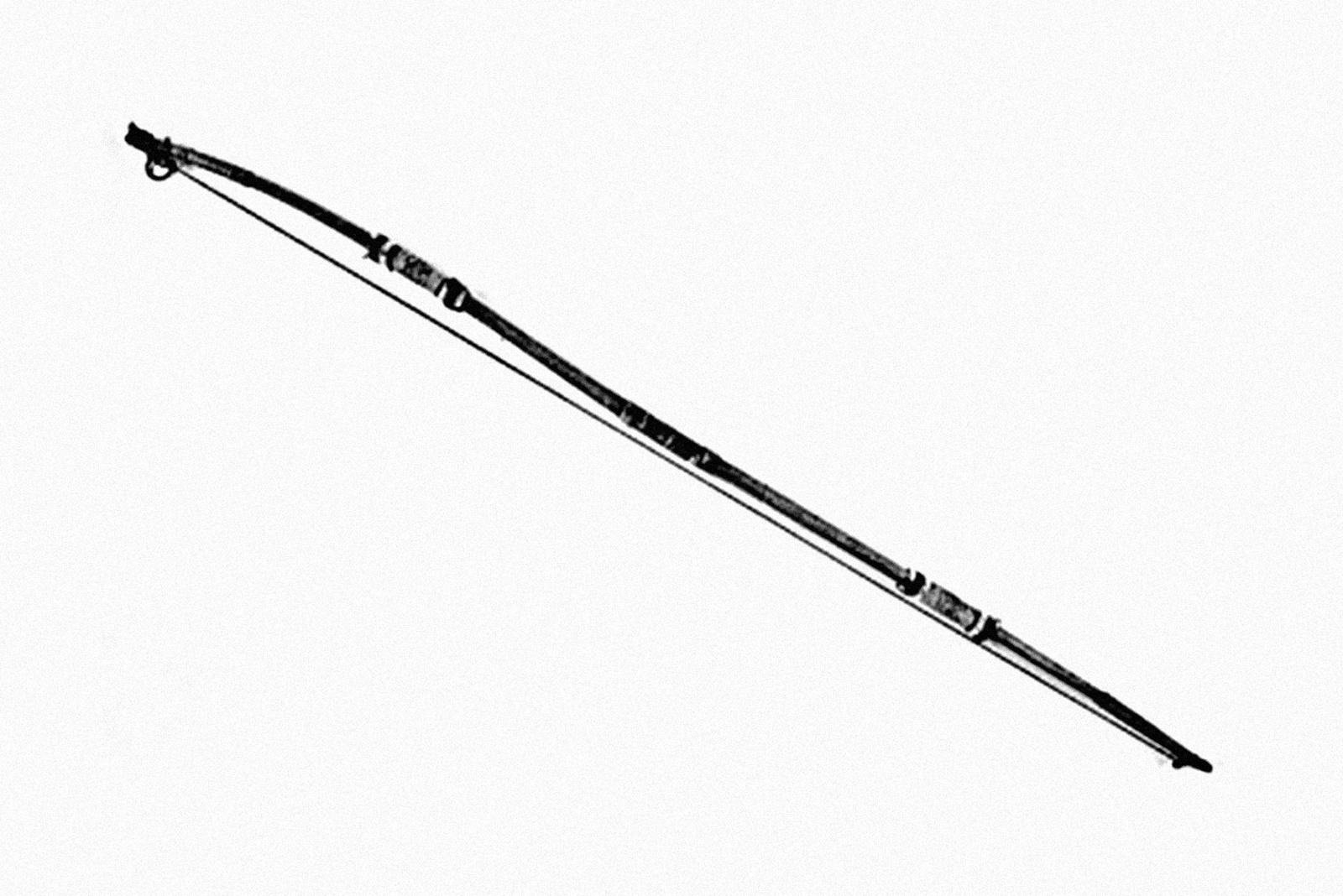
Takintazipa from the Pitt Rivers Museum of Anthropology and World Archaeology, Oxford, UK
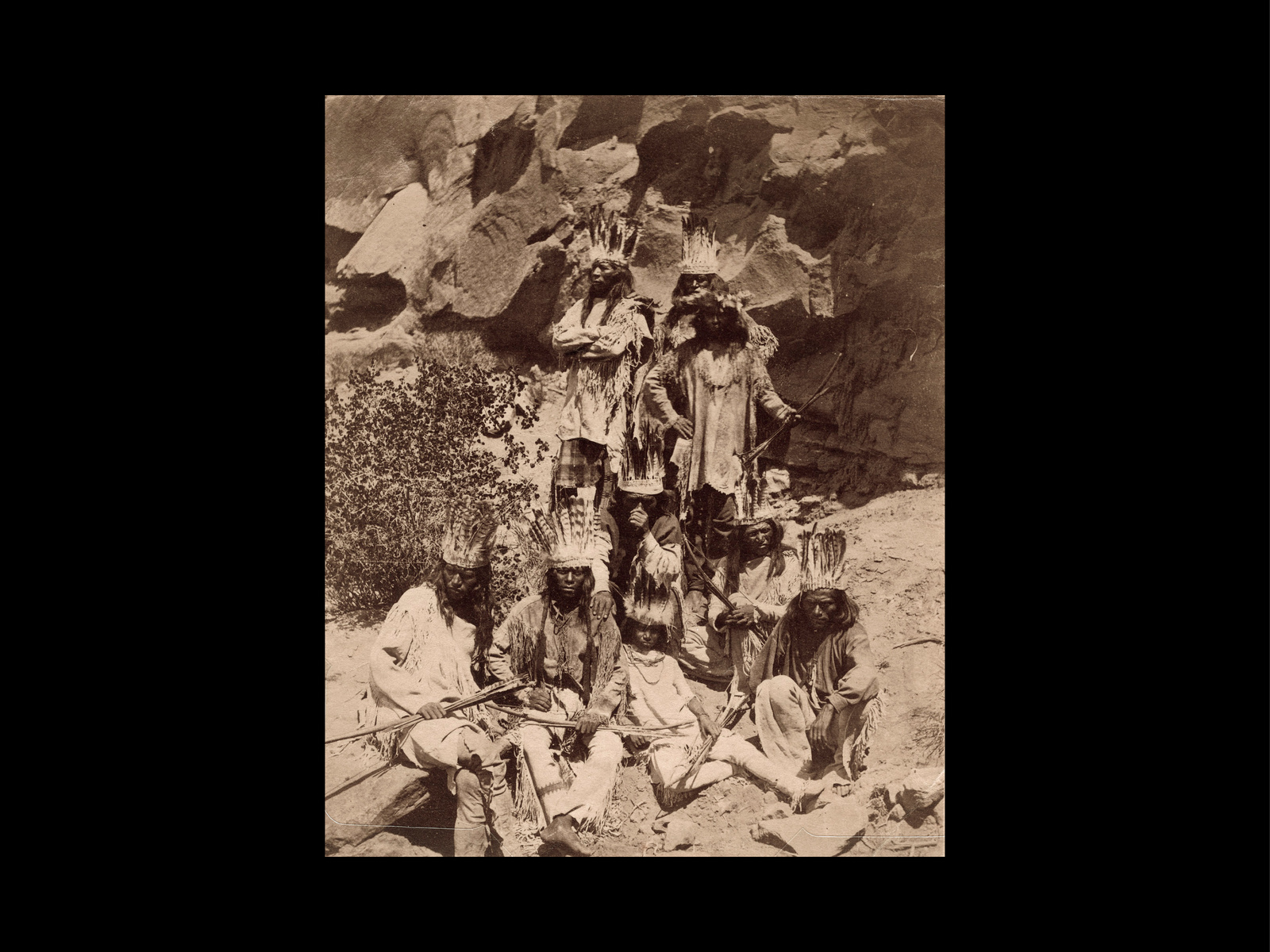
In another Americas display, seen on a visit to the V&A Museum in London, this photograph, taken by American government photographer John K. Hillers in 1873, was used to supplement a wall text titled “Hunting.” However striking, the buckskin costumes and headdresses that dignify the Southern Paiutes (pictured) are not traditional Paiute costumes. This scene was staged by Hillers and / or his commissioners. Here, art outweighs reality —the photograph only depicts a colonial conception or expectation of the Paiutes.
1.3 Saying Arrows
A vernacular constitutes events apart from ends; it refuses instrumentality, evades the gridded centrism of capital, supports a meaning as uncontrollably embodied among others. A vernacular does not produce or even make; it supports, carries, enlivens and transforms an ethos, and only via a specifically and changeably embodied co-movement. — “Untitled Essay” Nilling, Lisa Robertson
According to Collins Dictionary, Cupid’s Arrow is defined as “the arrow that Cupid fires from his bow which causes the person struck to fall in love,” but this is somewhat of a mis-quote that conjures a simplified, and moreover, incomplete understanding of Cupid’s repertoire. Etymologically, classic mythology establishes that not all of Cupid’s arrows were in service of romance. In the section The Transformation of Daphne into a Laurel from the 8 AD book Metamorphoses, the Roman poet Ovid waxes:
Two diff’rent shafts he from his quiver draws;
One to repel desire, and one to cause.
One shaft is pointed with refulgent gold:
To bribe the love, and make the lover bold:
One blunt, and tipt with lead, whose base allay
Provokes disdain, and drives desire away.
In his quiver, Cupid carried not one, but two types of arrows—one with a sharp golden point, and the other with a blunt tip of lead. A person shot by the golden-tipped arrow would be filled with uncontrollable desire, and the one struck by the lead would be filled with aversion, and a burning desire to flee.
In 1944, Looney Tunes aired its “The Stupid Cupid” episode. The sketch follows a merry Cupid as he shoots his arrows at unsuspecting males of various species, immediately turning them into amorous, lovestruck Romeos. Daffy Duck, who had been shot the previous year (and who consequently got married and fathered children), is seen confronting Cupid and berating him with brute hostility. Undeterred, Cupid snickers and later successfully takes another shot at Daffy, prompting him to fall for an uninterested hen.

Say, keep your arrows out of other people’s business-esses… Buster! You shot me last year, and look what happened. Tied down. No more fun. Now look at me. A hasbeen. A henpecked duck. A canvasback Casanova. And it’s your fault, you bare-backed bandit. So beat it, bub. Take a powder.. SCRAM! — ”The Stupid Cupid,” Looney Tunes, 1944
In 1979, Paul McCartney and WINGS recorded their hit song Arrow Through Me. We hear McCartney lament: “You couldn’t have done a worse thing to me, if you’d taken an arrow and run it right through me,” and instantly the melodramatic lyric stirs an explicit account of heartbreak. Typical in poetically-charged conflations like this, the arrow is designated the role of the perpetrator, inflicting desire onto unsuspecting and pitiable targets so overwhelming it hurts. This classic scene of being struck by Cupid’s arrow so easily comes alive because it is in our collective memory that the arrow elicits swift, penetrative, and fleshly (real) pain.
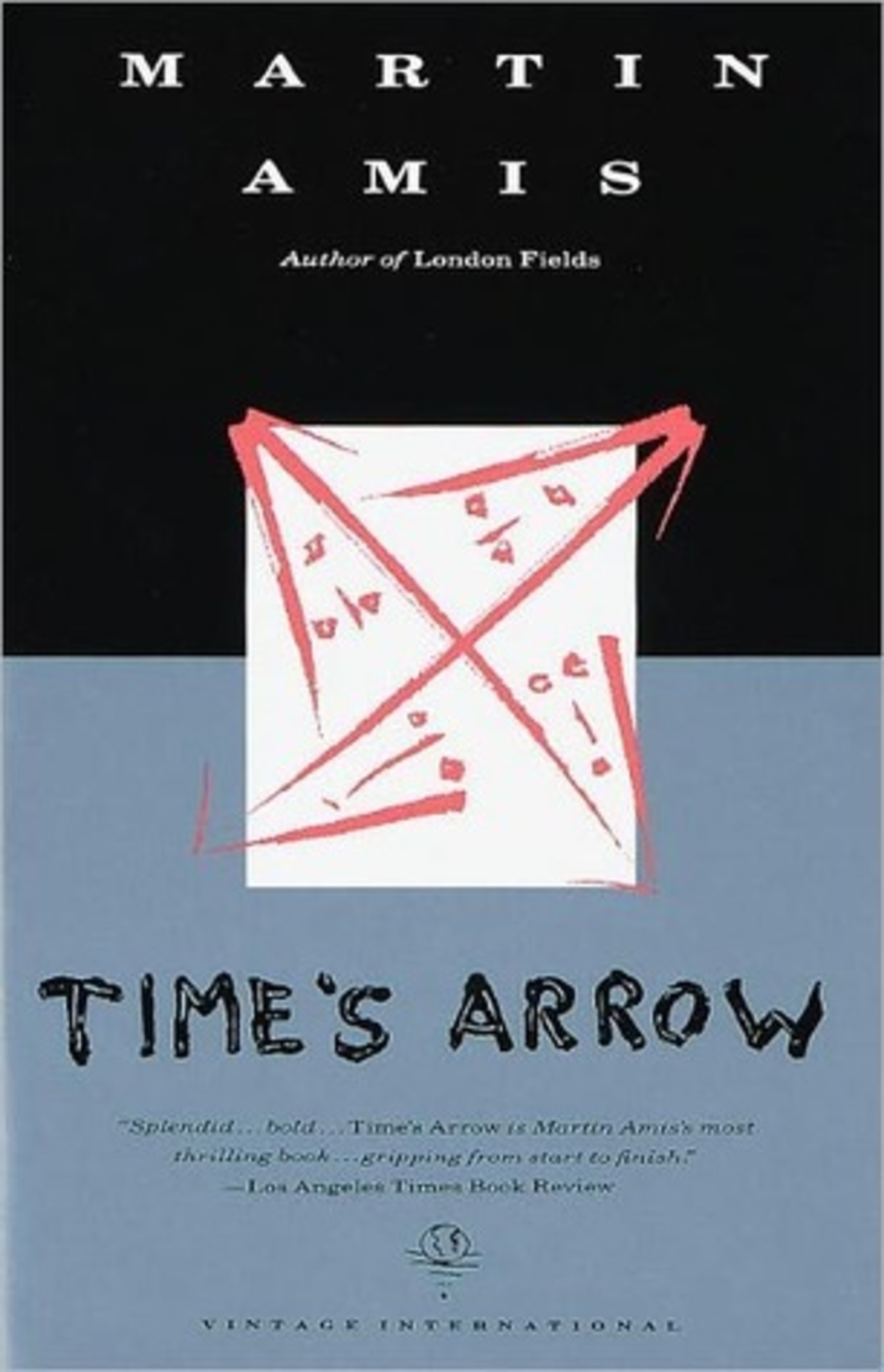
One iteration of a book cover for Amis’ Time’s Arrow features four sectored and ambivalent faces superimposed onto arrows pointing in opposing directions.
Relationally, and to return to the original premise of this text, it is worth thinking of Cupid’s arrow in tandem with “Time’s arrow.” Telescoped through a scientific lens, Time’s arrow may refer to the sequence of time’s passing as having a straight and one-directional trajectory, akin to the kinetic projectile of a flying arrow. In Amis’ novel, the arrow, going against the logic of forward motion, subverts the scientific dictum of time. Amis’s aberrant and illogical improvisation feels valid, because indeed the human experience of temporality can be felt and lived as aberrant and illogical, despite science. To quote Amis: “Like writing, paintings seem to hint at a topsy-turvy world in which, so to speak, Time’s arrow moves the other way.”
In essence, while the arrows used as literary metaphor quintessentially draw from reality, they are ultimately only propository in nature—projections of existing dynamics over which each of us must also claim our interpretative agencies. It is the fluid nature of these very dynamics that enable the historical continuity that Robertson attributes to the vernacular, requiring a certain poetics in order to remain alive.
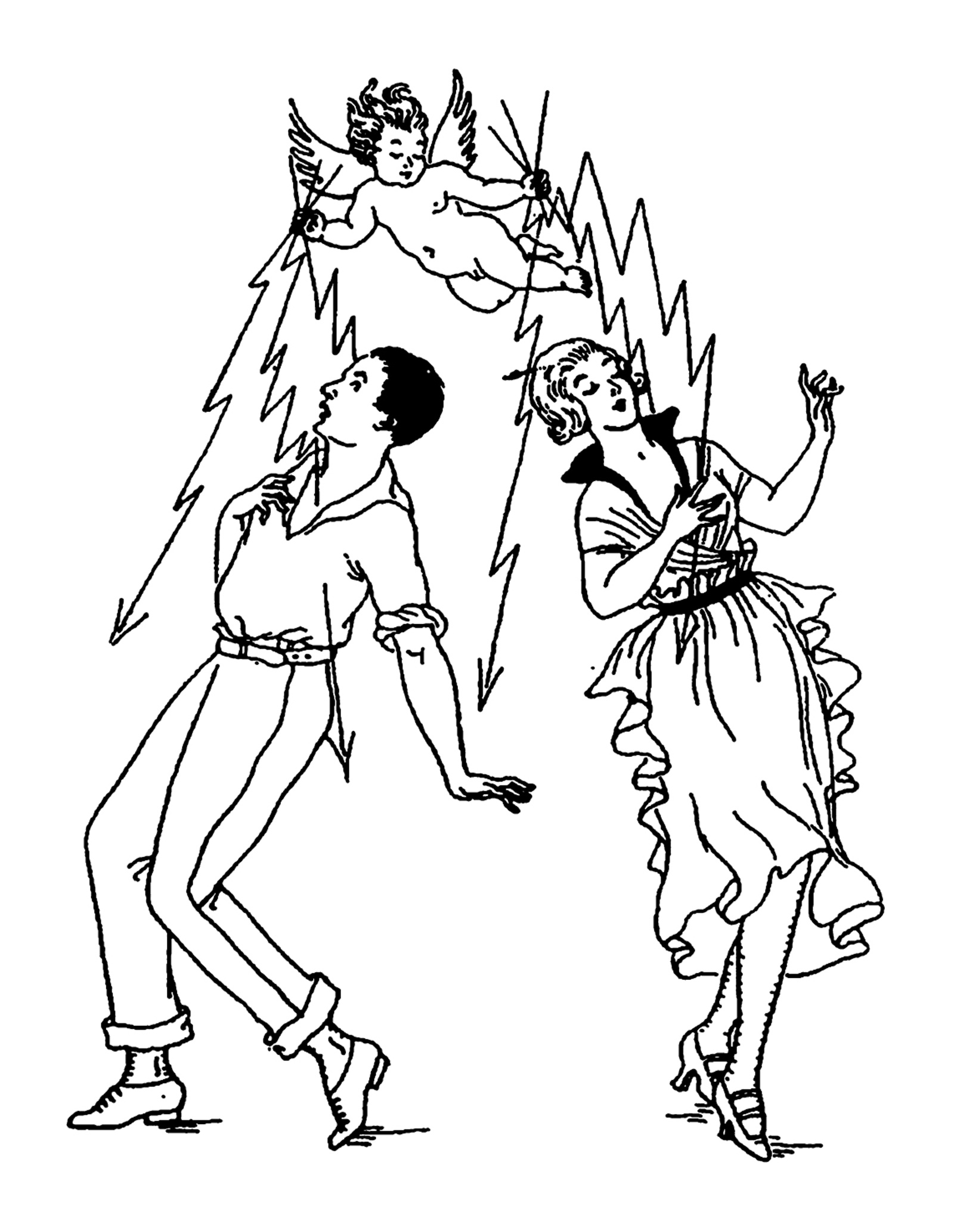
Struck by Cupid’s Arrow… as illustrated in the French journal Le Journal Amusant (1919)
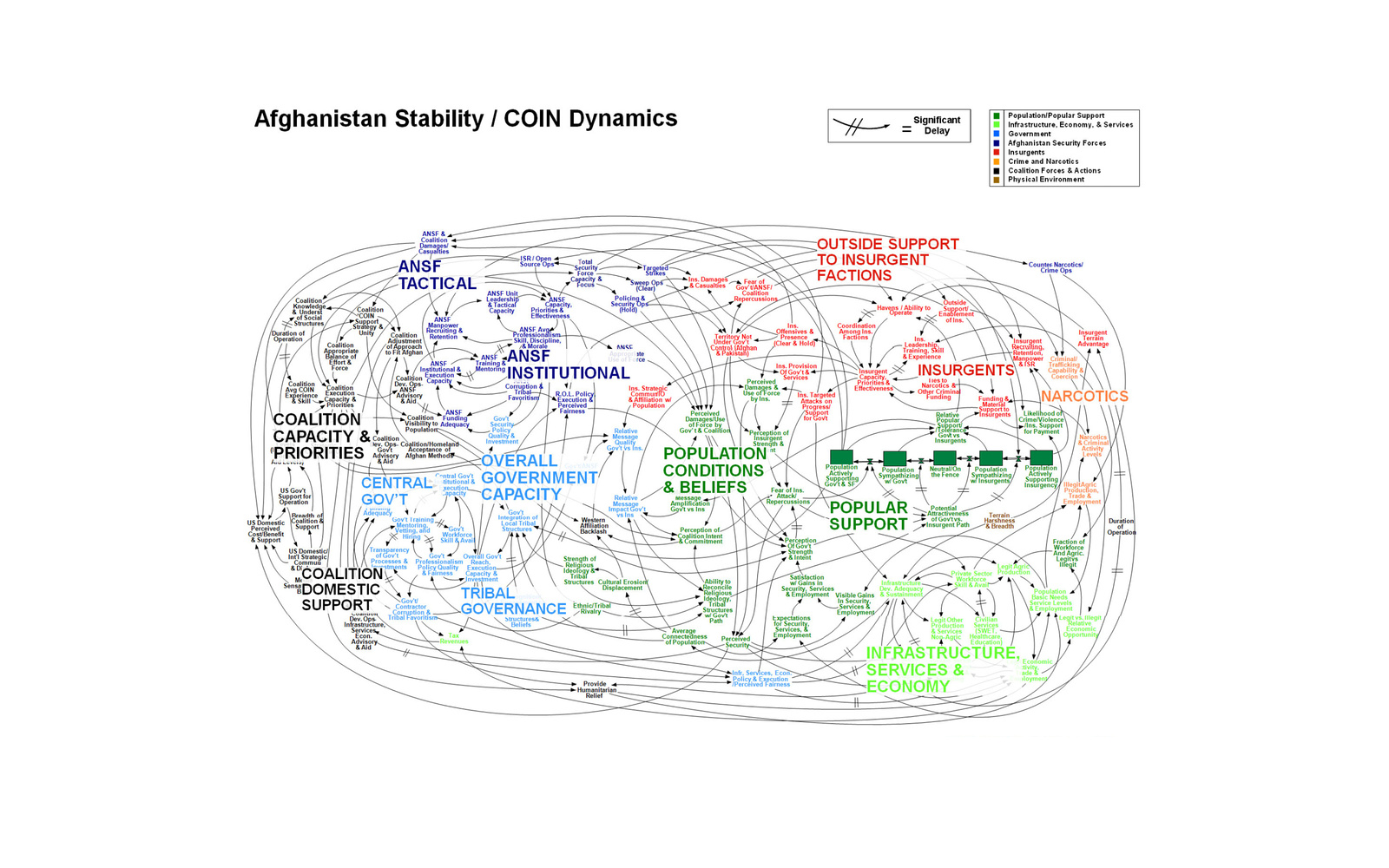
Part 2:
The ‘sign, which points in a particular direction’
2.1 Implication and Equivalence
The novel A Visit from the Goon Squad by Jennifer Egan was published in 2010. I was exhilarated by Egan’s entropic storytelling, particularly in her 12th chapter “Great Rock and Roll Pauses,” that is composed entirely of PowerPoint slides.
The chapter follows the twelve-year-old Alison Blake, who uses PowerPoint charts and diagrams rather than traditional prose to privately reflect on her complex emotions towards her family. In one of the 76 diagrams in the chapter, Blake endearingly interpolates her autistic brother Lincoln’s intricate layers of thought between what he “wants to say” and what he “ends up saying” into six key frames connected chronologically by a series of arrows.
By using the PowerPoint diagram format as a narrative device, Egan controls the pace of the plot by inserting pauses in a way that words are unable to. While these pauses might alternatively have been indicated in writing (i.e. “Alison paused for a moment”), the reader would still have to have actively engaged in reading words. Bounded boxes, connective arrows, and other graphic elements in these diagrams serve to negate words, visually grasping contemplative gaps between Alison’s statements, and poignantly revealing the unspoken je ne sais quoi of the young girl’s mind.
In April of the same year that A Visit from the Goon Squad came out, The New York Times published the article “We Have Met the Enemy and He is PowerPoint” by the journalist Elisabeth Bumiller. The article centered around a PowerPoint slide show from a Pentagon briefing—a complex visual flowchart describing American military strategy in the Afghan war, networked by a monumental web of arrows. It appeared to have “looked more like a bowl of spaghetti” to meeting attendees.
In her article, Bumiller reveals a subservient military culture that has come to heavily rely on presentation programs like PowerPoint to articulate the hierarchical order of a complex world. To quote:
Like an insurgency, PowerPoint has crept into the daily lives of military commanders and reached the level of near obsession. The amount of time expended on PowerPoint, the Microsoft presentation program of computer-generated charts, graphs and bullet points has made it a running joke in the Pentagon and in Iraq and Afghanistan. (…) “It’s dangerous because it can create the illusion of understanding and the illusion of control,” General (Herbert R.) McMaster said in a telephone interview afterward. “Some problems in the world are not bullet-izable.
Both the PowerPoint diagrams in Egan’s novel and the US-Afghan flowchart function within an Activity-on-Arrow (AoA) framework, in which core competency lies in simulating start-to-finish relationships that span the time from the event at the start of the arrow to the event at the end of it. However, AoA paradigms operate heuristically, which can too easily suggest that a relation is simpler than it really is, consequently thwarting our understanding of reality and its nuances. While in her novel Egan used this trait to her favor, heuristics tend to be less poetic and more adversarial when used to communicate vital issues between parties (i.e. national healthcare or military relations), where the connective tissue that flows between events may be as important as the events themselves.
If presentation programs like PowerPoint are used as diagram generators, and a diagram is essentially a mechanical outline of how something works that shows the relationships between parts of a whole—the users of these systems and programs must be recognized as active agents complicit in the politics of representation, and in how worldviews are shaped. The tools nested within these programs are also complicit in these politics, and should not be assumed as neutral.
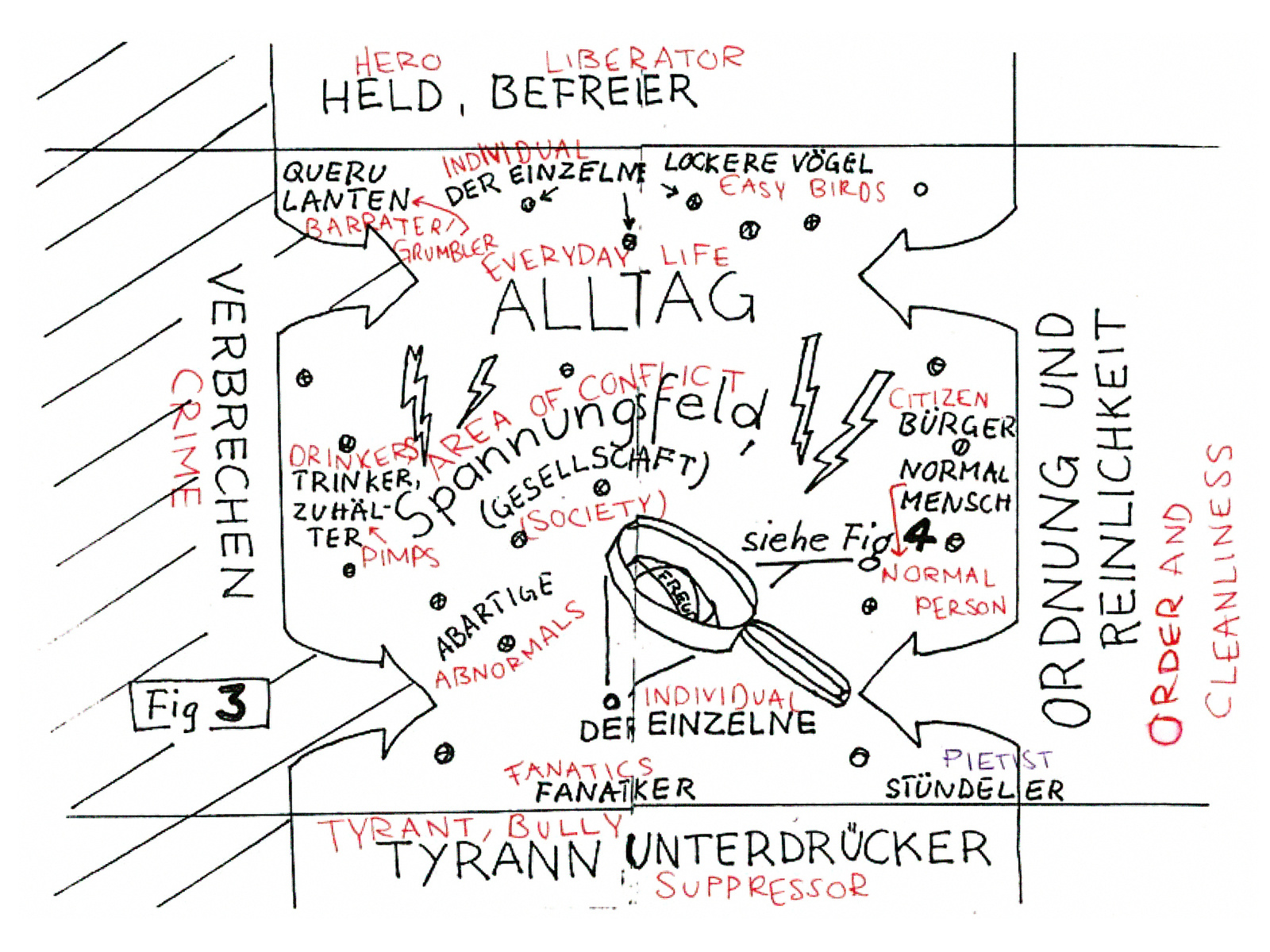
Peter Fischli & David Weiss, Ordnung und Reinlichkeit (Order and Cleanliness) (1981)
As a symbol of implication and equivalence, the arrow can be further considered through Peter Fischli and David Weiss’ series of drawings, “Ordnung und Reinlichkeit (Order and Cleanliness)”—schematic diagrams that chart human sentiments and their worldly relations. In the third diagram of the series, Verbrechen (Crime) and Ordnung und Reinlichkeit (Order and Cleanliness) are two free-standing categories that have outward-pointing AoA arrows that direct them to Alltag (Everyday Life) and Spannungsfeld (Conflict), but themselves never meet.
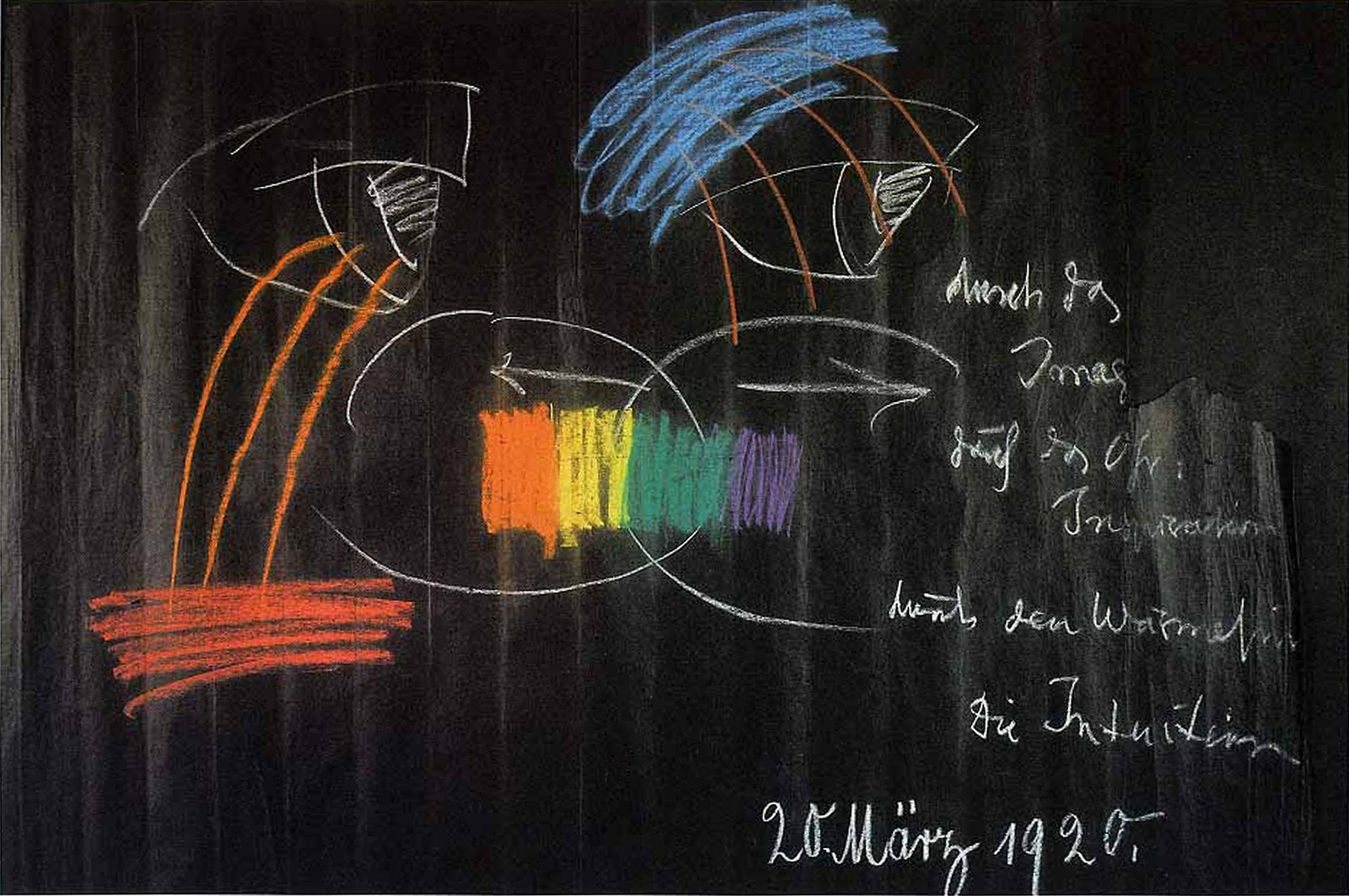
Rudolf Steiner, Untitled (Blackboard drawing from a lecture held by Rudolf Steiner on March 20, 1920) (1920)
These diagrams were influenced by and described as parodies of the blackboard drawings by Rudolf Steiner, the father of Anthroposophy (the philosophy asserting that an objective “spiritual reality” can be accessed and experienced through intellectual quest). In his 1923 lecture “Color and the Human Races” (originally transcribed in German in his book Vom Leben des Menschen und der Erde – Über das Wesen des Christentums), Steiner made claims that race was of central importance to properly understanding this spiritual reality—and moreover that different colored groups corresponded to different levels of evolution (“whites” being the most intellectually evolved). Seen through the lens of an AoA framework, color (A) is used here as the starting point to justify the totalizing suppression and displacement of peoples (B). In my reading of these drawings, they privilege a unilateral directionality of past and future—abstracting and therefore negating entire notions of subjectivity.
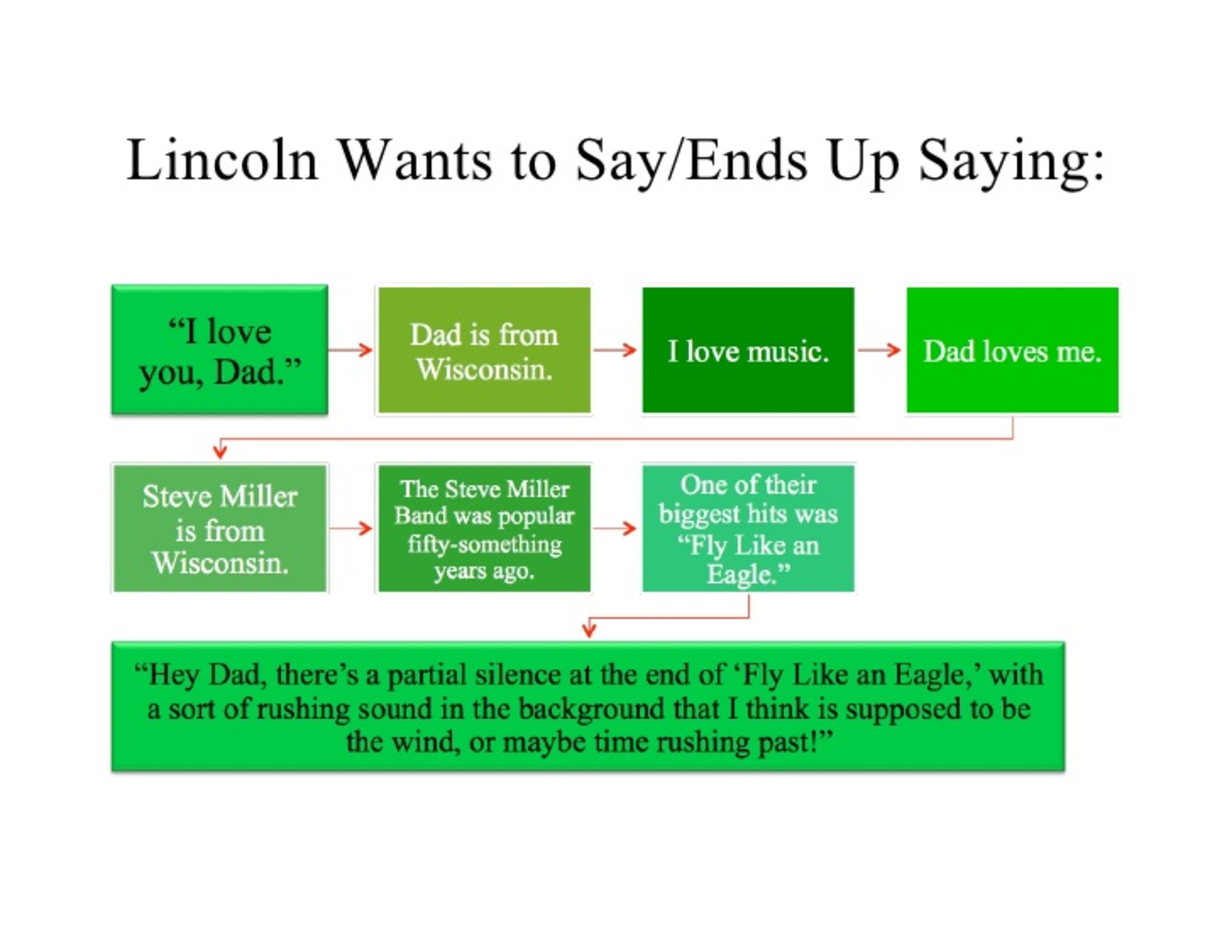
Chart from Jennifer Egan’s A Visit from the Goon Squad (2010)
2.2 Transiting
Not so long ago, an article with the headline “Man arrested for putting fake arrows on the floor in IKEA and creating a labyrinth with no exit” went viral across social media platforms. The article is obviously satirical. The headline accurately captures the arrow’s main function as a pivotal way-signifier in environments that operate through the establishment of boundaries, divisions, and other generalized categories of space.
In the essay “The Arrow —Directional Semiotics: Wayfinding in Transit” by semiologist Gillian Fuller, Fuller analyzes the function of the arrow in the mapped space of the airport:
A complex of forces move through (the arrow) which relates a more complex reality than the essentially hermetic world of signification. (…) These signs, like links and buttons on computer interfaces, conjoin semiotic and material flows in a world where the informational and the material increasingly stream through each other.
In navigating these spaces first-hand, the arrow is designed to be interpreted as a condition which limits responsive action—to be obeyed, not philosophically contemplated. In graphing out the absolute localities of “here” and “there,” the arrow denies further representation of the subjectivities and dependencies interspersed between wayfinding markers. The body must move, for to idle is to be in uncharted limbo, and—whether by knowledge or faith—the arrow exists as an “excellent mechanical help” in interpolating within a schematized blueprint. Every move made in the present curtails the future in precise, calculated ways. Where the body ends up is both destiny and destination—pure logistics.
Looking back at the logic of AoA, a compliant body threading through arrow to arrow in mapped space can be tangentially seen as the “activity” in AoA, traversing through the arrow’s shaft from point to point. Furthering this analogy, the ways that bodies move in charted space can be distilled to calculable responses within mechanized space. In this way, the “sign, which points in a particular direction,” through its tireless and incessant pointing, can be understood as instrumentalizing bodies and caricaturing the spaces it is thought to be subservient to.

via ThereIsNews.com (2018)

Arrow Logos: FedEx (1994)

Arrow Logos: Subway (2017)

Arrow Logos: Hillary Clinton campaign (2016)

Arrow Logos: Amazon (2000)

Arrow Logos: Carrefour (1966)
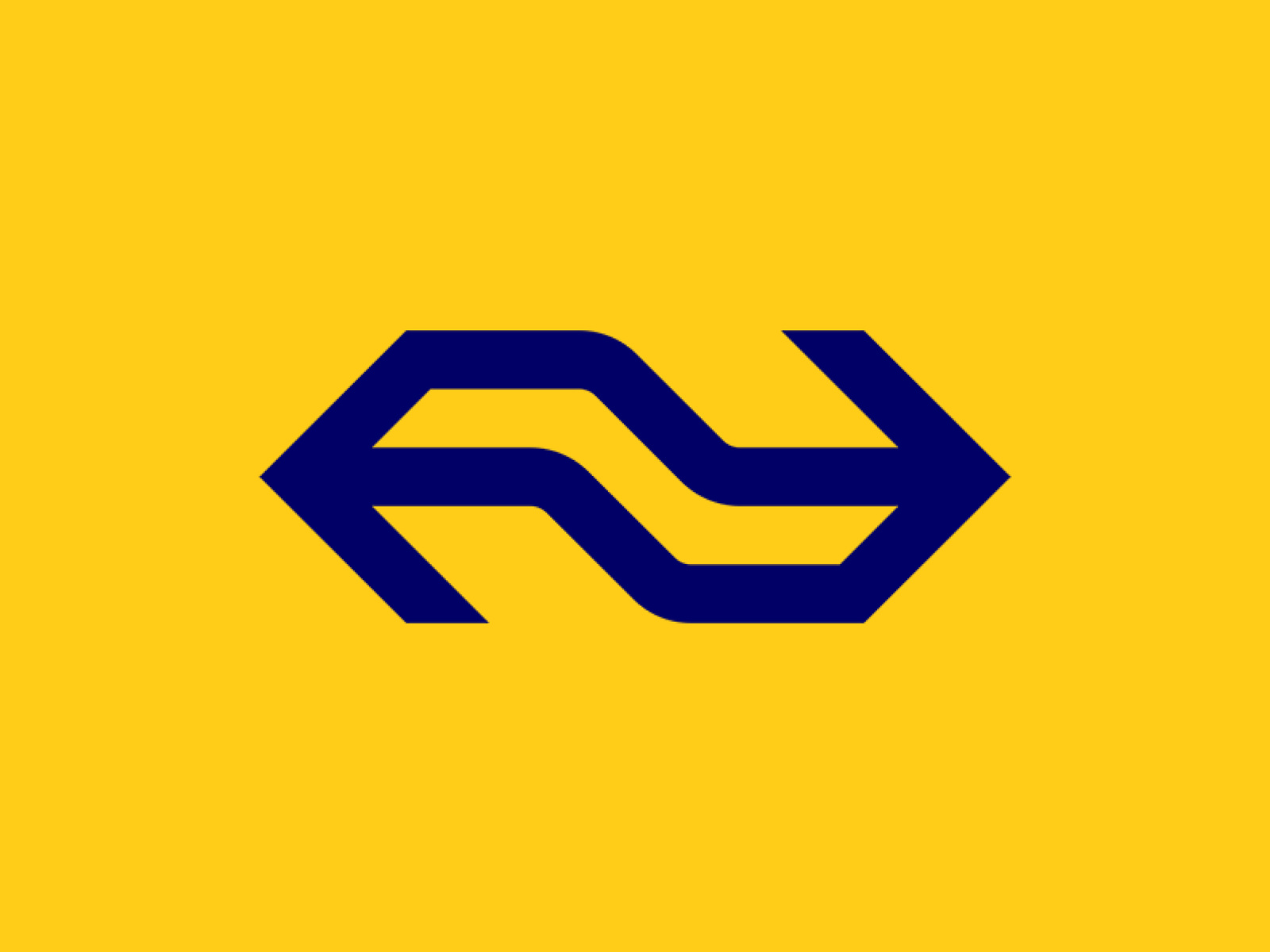
Arrow Logos: Nederlandse Spoorwegen (1968)
2.3 A—Z isms, TINA, and Indoctrination
The FedEx logo was designed in 1994 by Linden Leader and Landor Associates. During Leader’s design process, he noticed that with the right typographic configuration, the negative space created between the “E” and “X” could form a right-facing arrow. Eventually, Leader achieved his ideal symmetry by borrowing the “X” from the typeface Univers 73 and combining it with another typeface, Futura’s, “E.” FedEx would later explain that the hidden arrow was intended as a subliminal symbol for speed and precision.
In 2000, Amazon introduced their orange arrow as part of their logo. Designed by Turner Duckworth, the wordmark “Amazon” features a curved arrow leading from under the “A” and ending with a dimple under the “Z’” It’s meant to convey that Amazon carries everything from “A—Z”—their essential proposal for 1-stop shopping. Simultaneously, the arrow is shaped like a broad smile to, in their words, “match the vitality of the brand and to reflect our most important core value of meeting customer satisfaction.”
There are many other logos across a spectrum of industries that have adopted the arrow in their corporate identity marks. But while we understand that the arrow describes the process of movement, what exactly makes it so attractive?
The philosophical term logos—from which the “logo” that we associate with brand marks derives—provides some clues. Logos is the logic and rhetoric used as evidence and in argument to persuade. Translated from its original Greek, logos literally means “I say.” In corporate branding, a logo is an emanation of market sovereignty. What I want to draw attention to here is that if logos necessitates the presence of an active and persuadable audience, this also automatically implies that every “I say” assumes the necessary subjugation of a “you” to “listen.” Over time, this one-way dialogue essentially becomes a form of indoctrination when one is unassuming, unquestioning, or plainly compliant. The existence of official written documents (contracts, corporate brand guidelines, and press releases) only exist to confirm and protect the ideologies of arrows within these businesses, explicitly encumbering “you” from making interpretative gestures that might otherwise divest their militant corporate idealisms.
Relating the philosophy of logos back to the arrows in the FedEx and Amazon logos, I say that since these giants deal with the movement of goods from one point to another, these right-facing arrows with their forward-pointing trajectory (my extrapolation, based on the Latin left-to-right reading order) symbolize their capability to deliver on their same-day shipping promise. I say that much like an arrow flying towards its target, these arrows suggest reliability, efficiency, and exponential progressivity.
Yet, while Amazon continues to be lauded as a near-magical entity by customers and stock analysts, the company also faces scalding reports attesting to poor working conditions across their fulfillment warehouses, the logistical heart of their business. Upon closer examination, it is apparent that while Amazon continues to proliferate its A-to-Zisms—or “choices,” in their words—the consequences go far beyond the packaged simplifications understood by their consumers. Around the world, Amazon has been heavily criticized for exploitative, unsafe, and plainly unfulfilling treatment of their “low-level” employees in order to keep up with unworldly speeds that hark back to a time when industrial laborers were regarded as nothing more than replaceable cogs in an engine. Between poorly insulated spaces, physically shattering twelve-hour shifts, abusive upper management, and timed bathroom breaks, the intensity of these grueling conditions have resulted in workers’ frequent collapse from exhaustion while on the job. These conditions are extensions of market logic.
In thinking of these arrows—embedded, subsumed, and mummified by capital—I mused that a fitting category for them might be “There is No Alternative” (TINA). Popularized in 1980s Britain by then-Conservative prime minister Margaret Thatcher, the acronym “TINA” was Thatcher’s assertion that a free-market economy was the only system that would work for a modern Britain, precluding any further debate.
In Noam Chomsky’s book Rogue States: The Rule of Force in World Affairs, he describes TINA as a dangerous proponent of wilful oppression; a detrimental force that radically negated the common good of society: “In the past century the idea that such entities have special rights, over and above persons, has been strongly advocated. The most prominent examples are Bolshevism, fascism, and private corporatism… two of these systems have collapsed. The third is alive and flourishing under the banner TINA to the emerging system of state corporate mercantilism disguised with various mantras like globalization and free trade.”

The Amazon arrow, flipped upside-down and subverted to form a scowling face, has become a protest symbol adopted by protesters and labor advocates in public demonstrations all around the world.
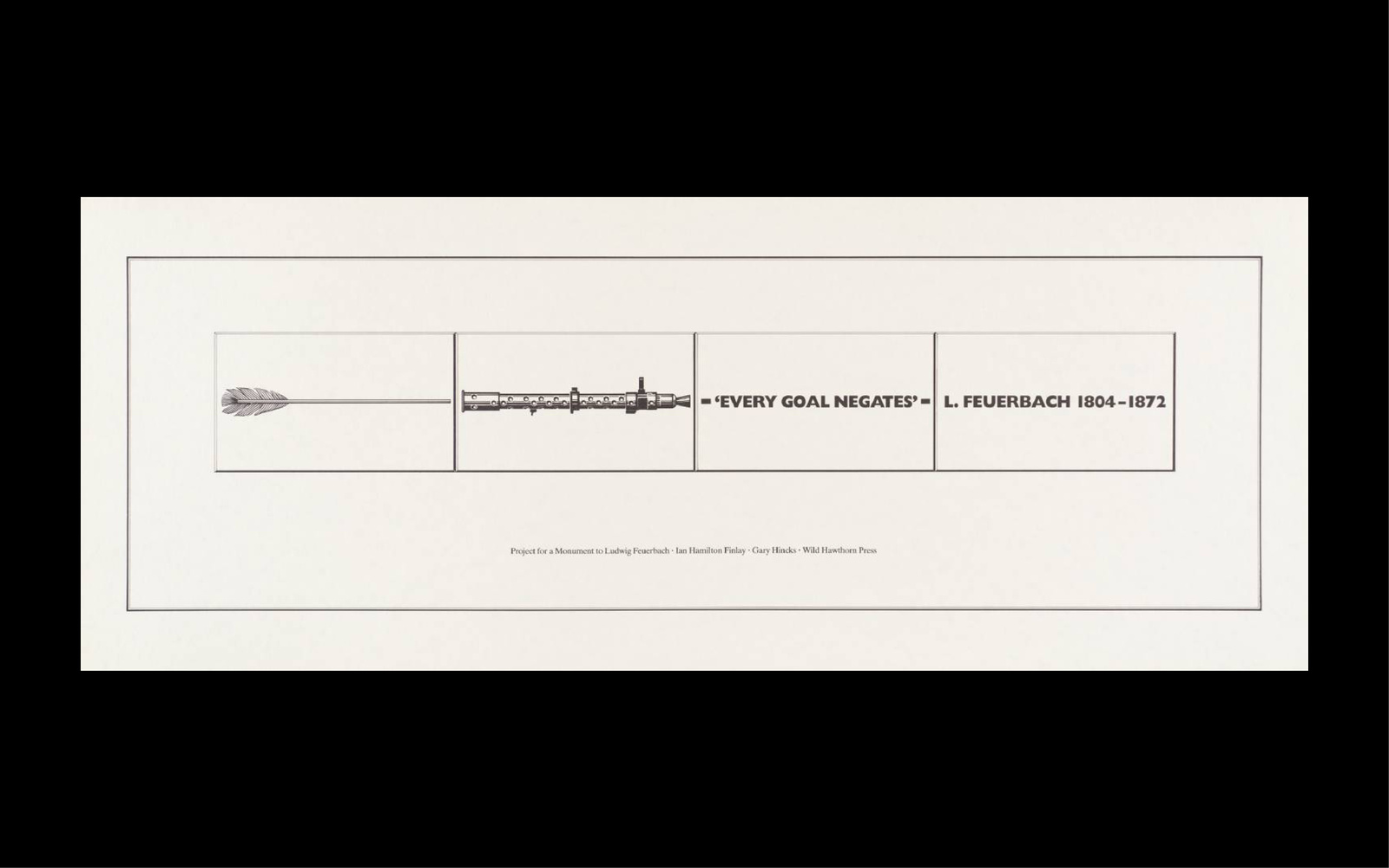
Part 3:
The Nature of the Offense
I encountered Ian Hamilton Finlay’s lithograph Project for a Monument to Ludwig Feuerbach last summer while at the Museum of Contemporary Art in Antwerp. The print features four main panels (from left to right): 1. A crop of an arrow’s fletching and shaft; 2. A crop of a rifle barrel; 3. and 4. The quote “Every Goal Negates” by German philosopher Ludwig Feuerbach. “Every Goal Negates” was extracted from Thoughts on Death and Immortality, written in 1830 by Feurbach:
Every goal negates; where there is no destruction, no negation and sacrifice of independent existence, there is no purpose. Purpose is Spirit, but Spirit is the death, the destroyer, of sensible reality.
What Feuerbach claims is that the act of conquering necessitates revision and redirection, which in one way or another implies the negation of the past and pastness. The establishment of new goals, and the uprising of new practices, methods, and technologies developed to reach them, spells imminent doom for its predecessors—relationships need re-examination and potential overhaul. In Finlay’s print, we only see that the rifle succeeds the arrow, but the quote reads like a mantra suggesting that this overwriting continues insofar as new dominant forces surpass old ones, and so on and so forth, alluding to a cause-and-effect simplicity and directionality of past and future history.
In this essay I propose that “the sign, which points in a particular direction” is a different kind of weapon than the “long, thin stick, pointed at one end, that can be shot from a bow”—the latter of which has become a dominant symbolic force since having outmoded the rifle.
The offense never lies in the arrow(s) ipso facto, but in the underlying and overarching politics of its various uses and disseminations across time. The offense follows the arrow’s journey from a largely abstracted, antiquated past to present-day modernity—a legacy defined by and for history’s conquerors and their achievements. This, all while inconvenient narrative strands—“sensible reality” as Feuerbach would describe it—are neatly stroked out. It would appear that the voicing of historical truths in relation to a single dominant force is easy, for they get to dictate the terms upon which such truths are articulated. Voicing the truths of the marginalized is a far more arduous task, and such an endeavor requires humility—the negation of personal ego.
What was negated when the rifle outmoded the “long, thin stick, pointed at one end, that can be shot from a bow”? One historical trajectory points to a widespread colonial violence enabled by one side’s advancement of military artillery (and subsequent ability to conquer the less-advanced Other), like the British authorities on the Andaman islands, or the European explorers on Sioux land. Behind the glorified narratives of Golden Ages and the discovery of New Worlds are the unannounced but nonetheless omnipresent realities of alterity, dispossession, and genocide.
In researcher Rolando Vázquez’s paper “Precedence, Earth and the Anthropocene: Decolonizing Design,” Vázquez characterizes Modernity as a notion that negates factions of other lived experiences beyond the dominant colonial voice:
Modernity’s notion of humanity and civilization is produced as Earthlessness. This negation is not the sign of a chronological superseding of a new epoch over another, of the modern over the non-modern; it has been an active historical movement of erasure, obliteration and oblivion, it actively characterizes the modern/colonial order. Modernity was built through coloniality, through concrete cognitive and material processes of production and suppression of alterity. Modernity has relegated nature, bodies and other worlds of meaning to a negated alterity, to forms of non-existence, to worldlessness. To look at the production of alterity, of the outside of modernity’s world historical reality, is to see the movement of coloniality.
What was then negated when the “sign, which points in a particular direction” outmoded the rifle? One trajectory points to the “long, thin stick, pointed at one end, that can be shot from a bow” taking on a new appearance in order to exert a new type of performance for the means of communicating a comparatively oblique and sophisticated sort of destruction.
By the mid to late 19th century, the graphic arrow (i.e. >), in its familiar and fundamental form, started to appear in scattered traces thought to have been first propagated through the maps of English cartographer Emil Reich in his 1903 textbook A New Student’s Atlas of English History. In translating the aerodynamic arrow into a universal symbol for logical and sequential equivalence, the fletching was regarded as an arbitrary ornament and was subsequently removed. In this example, Reich used arrows to cartographically denote military movements in the 1794–1795 English campaign in the Netherlands.
By this time, capitalism had also intensified and gained dominance, becoming the modern economic system under which society still functions. Things that might have previously been fought over with artillery were re-established as commodities instead—first evaluated, and then sold and traded within an economic infrastructure. These activities and transactions were officiated by the means of bureaucratic documents, such as contracts. Vázquez describes the nature of the commodified goods as such: “The commodity is a mysterious thing, simply because in the coloniality that has led to its production, the extraction from Earth and the exploitation of people appear as a libidinal object of consumption. Its power of attraction is, in a perverse way, the manifestation of the consumption of life.”
As a “sign, which points in a particular direction,” the arrow in its streamlined form has become a ubiquitous figure for Western modernity (hastily exported to the rest of the world)—a mechanized rhetoric used to relegate and instruct bodies to “move” or “do” or even “be”—a vacuous automatism in service of the market and its values and principles.
Thus, the cartographic and diagrammatic arrow has evolved into a mediatory and instrumental one. This trajectory optimizes a scenario where symbols serve an unbending structure of internal management from the hegemonic social classes, exploiting and dispossessing those below it. This type of arrow has a flexibility of use and repressive penetration that is without a doubt—the kind of violence it perpetuates is subliminal, slow, and sterile. It avoids the messiness of bloodshed, and leaves no stains.

Map from Emile Reich’s A New Student’s Atlas of English History (1903) utilizing arrows to show military maneuvers.
Part 4:
Turning
In a turn, we turn away from something or towards or around something and it is we who are in movement, rather than it. Something in us is activated, perhaps even actualised, as we turn. — Turning, Irit Rogoff
The arrow radiates an immanent sense of directionality, optimizing the idea of one-directional smooth passage—but as witnessed in Amis’ aberrant use of the term “Time’s arrow,” the fundamental message of directionality can also be manipulated and built upon. Ultimately, the figurative arrow need not exclusively function as an A-to-Zism, but can curve back on itself to mark a turn to perpetuate a shift—analogic notions of a “redo,” or an “undo.”
As a last note, I want to think of possible gestures of turning—specifically, away from the linear rigidities that stem from colonial dichotomization. In the times that we live in, when might so-called modern behaviors and tendencies prove problematic, and how might we then avoid perpetuating them?
In the 2006 research paper “With the Future Behind Them: Convergent Evidence From Aymara Language and Gesture in the Cross-Linguistic Comparison of Spatial Construals of Time” by cognitive scientist Rafael E. Núñez and linguist Eve Sweeter, Aymara, an Indian language of the high Andes, and the unique way that its speakers think of time is dissected. Aymara speakers perceive the future as behind them, and the past as ahead of them. They call the future qhipa pacha / timpu (back or behind time) and the past nayra pacha / timpu (front time)—they gesture ahead of them when remembering things past, and backwards when talking about the future. My hypothesis here is that Aymara infers not vision, that of which speculates (i.e. “A bright future in front of us”)—but more modestly with sight, and more fundamentally with where our eyes are situated. The past can be seen with clarity, since it has already happened (front); the future is blind, for the latter is unknowable (back).
The way that Aymara explains past and future through language thus postures Time’s Arrow (as being forward > future-centric) as only one possible construct. It illustrates that time—and by extension, history and historicity—can also be experienced and lived in a plurality of other ways.
Turning towards the plural notion that temporalities might be understood relationally can overcome the modern epistemological frameworks that only seem to reiterate colonially historiographic narratives. If the idea of plurality can be fundamentally embraced, I believe that it can open up a deeper capacity for restoration whereby the space, generosity, and embodied value that is already so often gratuitously granted to dominant voices—like those of the scientific, moral, or holy—can be granted to marginalized narratives.



